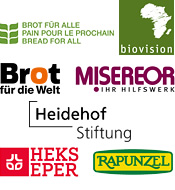Meat and Animal Feed
Today, however, most fattened livestock no longer eat grass and are kept in increasingly bigger factory farms and are fed with concentrated feedstuff based on soybean, rapeseed, maize, wheat or other grains instead. Grown on arable land, the production of animal feed thus results in land for direct food production being lost. This is increasingly becoming a problem if the competition for food is “outsourced” to other countries or regions. The EU, for example, imports more than 70% of protein crops for its animal feed, mostly soybean and soy meal from Brazil, Argentina, Paraguay and the United States. The area used in these countries for the production of such export crops is equivalent to 20% of the entire surface of arable land in the EU. Rainforests are cut down and large pasture areas are converted into cropland for the cultivation of soy. Not only is this a catastrophe for global biodiversity and climate protection, it also negatively impacts soil fertility due to large monocultures."At the global scale, soybean is one of the fastest expanding crops. (...) Deforestation for soybean expansion has been identified as a major environmental threat in Argentina, Brazil, Bolivia and Paraguay. In part, area expansion has occurred in locations previously used for other agricultural or grazing activities, but additional transformation of native vegetation plays a major role.“ (Global, p. 284)
In Europe, the cultivation of soy and other domestic protein crops such as broad beans, field peas and lupines, has not been competitive for decades even though the cultivation of leguminous plants has many advantages. Legumes can fix nitrogen from the air in symbiosis with bacteria at their roots, thus replacing mineral fertilisers or animal manure. Leguminous plants could make an essential contribution to climate protection and soil fertility. On that issue, there is agreement between the EU agricultural ministers and the European Parliament. However, during the last reform of the Common Agricultural Policy, they did not manage to establish the cultivation of leguminous plants as a mandatory part of the minimum crop rotation. In the framework of the so-called greening, they gave farmers the possibility to cultivate leguminous plants on 5% of their fields, thus enabling them to fulfil their “Ecological Focus Area” requirement, which would actually be obligatory.
Climate killer number one
The industrial production of meat, milk and eggs, which is no longer tied to pastures, first requires the cultivation of many times the amount of calories in the form of cereals and oil seeds. These crops are mainly cultivated in highly energy-intensive monocultures. In addition, ruminants emit the dangerous greenhouse gas methane and livestock causes ammonia emissions from manure and dung. The livestock sector is therefore responsible for by far the biggest contribution of agriculture to climate change."The livestock sector has enormous impacts on the environment: it is responsible for 18% of GHG emissions measured in CO2 equivalents, and 9% of anthropogenic CO2 emissions, including the combustion of fossil fuels to make the additional inputs. Globally, it accounts for about 8% of human water use, mostly for the irrigation of feed crops. It is estimated that 1 kg of edible beef results in an overall requirement of 20 to 43 tonnes water per kg of meat (...) In the US, livestock are responsible for 55% of soil erosion and sediment, 37% of pesticide use, 50% of antibiotic use and a third of the loads of nitrogen and phosphorus into freshwater resources." (Global, p. 518, 520)The extremely negative impact of meat and dairy production on the climate could partly be mitigated by improving the composition of animal feed in order to reduce methane emissions. Additional sources of feed, for example from organic waste and unused bycatch in fishery, could also enhance efficiency in this area. Furthermore, a better distribution of meat production facilities is necessary in order to reduce transport distances and allow for the use of animal dung in those places where nutrients were removed from the soil.
Need for change in consumer habits
Although the IAASTD does not give recommendations with regard to consumer habits, the results of the report only allow for one conclusion: The consumption of meat and dairy products in industrialised countries has to be reduced and consumption in emerging countries has to be limited to an acceptable level. These are the most urgent and most effective steps that must be taken to achieve food security and to protect natural resources and the climate. Considering the disastrous consequences of meat consumption, would it really be so radical to follow our grandparents’ tradition of a Sunday roast rather than eating meat every day? Not only would this be good for our health but also for food safety and the environment. The respectful treatment of farm animals would be beneficial to their well-being as well as to our self-respect. When buying meat at the supermarket, we would no longer have to suppress images of unbearable conditions in modern meat factories; of the destruction of forests, animal and plant varieties; or of global warming - all of which are consequences of this form of production - together with the decay of rural areas and farmers’ livelihoods.









